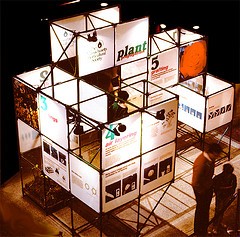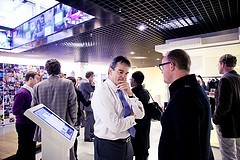The particulars of your presentation will depend on different things. Among those factors is the context of your presentation.

Are you presenting at a big industry event? Or are you discussing tasks with colleagues in a meeting? Whatever the case, different presentation tips and considerations apply for different occasions.
Seminars and conventions
These are often held in large venues like auditoriums. Usually, you’ll be presenting from a stage with a huge projector screen looming behind you.
For these occasions, the most important thing you have to think about is how well the audience can see your slides. This won’t be a problem for people sitting in the front row, but you’ll need to make sure that the experience remains the same for those seated in the back.
To avoid any issues with visibility, here are a few presentation tips to consider:
- Learn what you can about the venue beforehand – Ask the organizers about the particulars of the venue where you’ll be presenting. Estimate the stage size, and prepare for any restrictions.
- Optimize your presentation for the equipment – You should also check the equipment you’ll be using, especially the projector and the screen. Familiarizing yourself with the type of projector can also help you diagnose some PowerPoint display issues.
- Practice blocking and how you’ll move around the stage – Obviously, your presentation is more than your PowerPoint slides. As the presenter, the audience will also have to see you properly. Make sure you practice how you’ll move around the stage. Own as much of the space as you can.
Workshops
Workshops allow for more interaction between the audience and speaker. Because you’re expected to instruct the audience about a certain subject matter, the venue is optimized to make sure that there’s plenty of opportunity for face to face conversations.
Unlike seminars and conventions, the obstacle you have to overcome is making sure the audience can easily follow the structure of your presentation.
Here are some important presentation tips to remember when preparing for workshops:
- Make sure you can easily navigate through your presentation – A workshop involves two-way communication. Someone in your audience might start asking questions that you expect to cover in a later slide. When this happens, it helps if your deck utilizes hyperlinks for easy navigation.
- Distribute presentation handouts – A quick way to make sure the audience follows what you’re saying is by creating handouts. Distribute it at the beginning of your presentation and encourage them to add their own notes along the margins.
- Prepare to improvise – Lastly, keep in mind that because of its interactive quality, you can’t always stick to the script you planned. Always be flexible and don’t be afraid to follow the curve balls that the audience throws at you.
Executive or board presentations
When you’re presenting to executives or board members, keep in mind that the stakes are unbelievably high. In more formal business settings, the outcome of your presentation affects what comes next for your career. For instances like this, you need to value brevity and clarity above anything else.
Keep your delivery well-polished by following these presentation tips:
- Focus on your core message: Executives and board members aren’t interested in long and winding discussions. Get straight to the point and keep your focus on the core message.
- Back up your points with concise data: For formal business presentations, fancy rhetoric isn’t enough to win your audience over. You also need to make sure that your points are backed up by evidence. Present your data in a concise manner using eye-catching visuals.
- Take the time to rehearse: It’s totally normal to feel nervous about high-stakes presentations. To make sure things over perfectly, take the time to rehearse every aspect of your presentation. Learn your points and practice how you’ll incorporate your slides to your speech.
Small group meetings
There are also presentations that involve a smaller crowd. If you’re leading a meeting, you’ll likely face just a small group of participants. This doesn’t mean you shouldn’t be as prepared as you would be on other presentation scenarios. You also need to make sure that your points are well-prepared. Make the audience feel included in your discussion.
Stanford professor JD Schramm presents five questions to ask yourself when faced in small group meetings. Apart from his initial five questions, Schramm provides a few extra notes:
- Opt for a printed or tablet presentation deck: It will be easier to facilitate a small group meeting if everyone can navigate through your presentation deck at their own pace. Create a printed presentation deck instead. You can also distribute your PowerPoint file ahead of time so that participants can sync them to their own devices.
- Don’t take your nonverbal cues for granted: Even is small-scale presentations feel a lot more casual, you shouldn’t take nonverbal cues for granted. Make sure you present an aura of authority the same way you would while you’re on stage.
- Leave room for open discussion: Meetings are supposed to be collaborative in nature. Make sure you allot specific moments for the participants to join in your discussion.
—
There’s plenty to consider depending the context of your presentation. To achieve the best outcome, prepare according to context and occasion. These presentation tips will help you figure out what to consider.

Download free PowerPoint templates now.
Get professionally designed PowerPoint slides weekly.
Sign Up NowReferences:
“Designing PowerPoint Decks for the Smartphone.” SlideGenius, Inc. September 23, 2014. Accessed January 19, 2015.
“PowerPoint Design Tips for Presenting Data.” SlideGenius, Inc. December 1, 2014. Accessed January 19, 2015
“PowerPoint Tutorial – Hyperlinks.” UPenn Workshops. Accessed January 12, 2016.
Schramm, JD. “How to Present to a Small Audience.” Harvard Business Review. August 20, 2014. Accessed January 19, 2015.
“Tips for Small-Scale Presentations.” SlideGenius, Inc. October 13, 2014. Accessed January 12, 2016.
Featured Image: University of the Fraser Valley via Flickr





